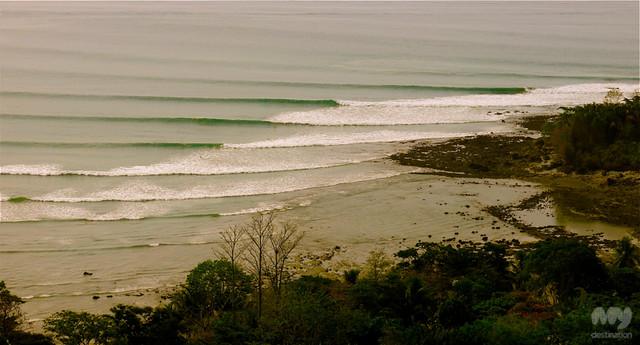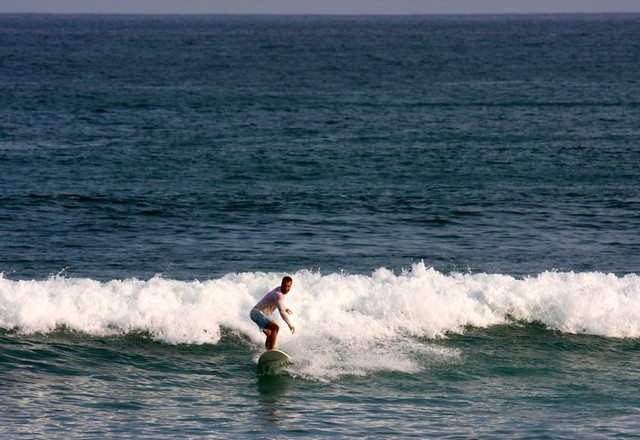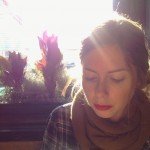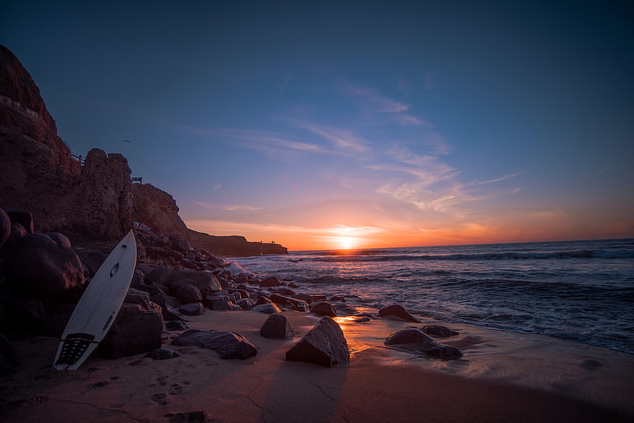We started out when the sun had just crested the distant hills on the other side of the bay. The dust on the road was barely visible without passing cars to shake it up, and the gravel crunched under our feet. It was 6:30 am. The air held a morning chill it would soon lose to the rising warmth of the sun. As we walked along the main road toward Matapalo—where we’d heard the best surfing was to be had—we saw a pair of green parrots flying overhead, squawking to one another in an early dawn exchange. The long, thin trunks of youthful Teak trees swayed from sided to side in their farm across the road. A gentle breeze scented with foreign honeysuckle lifted their leaves and everything was quiet except for the animals. Birds of all kinds making their morning music, monkeys howling in the trees beyond, unidentifiable grunts and groans from faraway forests that coalesced to fill the morning with animal song. Suddenly we heard a rumble from behind us. A car was approaching in a cloud of dust. We stuck out our thumbs and hoped for a ride.
Newbie Surfing on the Osa Peninsula
Matapalo: One Of The Best Surfing Spots
There are three beaches in Matapalo for surfing. The locals all agree that Pan Dulce is for beginners. Backwash gets the medium-sized waves, and Matapalo Beach is for only the advanced. As a first-timer I knew my limits and Pan Dulce was our destination. We got a ride from a kind farmer who spoke no English. We stood tall in the bed of his truck, resting our arms on the haphazard walls he’d built onto it for transporting larger materials. The wind was warm and we ducked under low-hanging branches as they blew past us. In a beautiful language of slow Spanish and meandering gestures he directed us to the resort where we would rent our boards.
Once we arrived at the Encanta Lodge, we met Brian, the owner who was very friendly and helped us select our boards. He had the nurturing nature of an ex-pat, coddling our naiveté to both the area and the sport with kindhearted advice in all areas. As we hoisted our boards under our arms he found us a piece of wax then sent us on our way.

Pan Dulce was inviting and unassuming. Like any outdoor activity, you are at the mercy of Mother Nature. Surfing is a lesson in patience; you have to wait for what you want. We had been told we would find the best waves in the morning at high tide, but what we found was a calm, glistening surface and a secluded beach with no other humans in sight. We paddled out, so that I could get used to the board. I quickly learned that a two-piece suit is not the best choice for surfing and especially not one with a twisted knot in the center of your breast bone made for easy bruising when you’re lying flat on your board and paddling into the surf. Also, watch out for the rocks. The beaches are notoriously rocky and surf shoes would do you well here. These are lessons that I readily impart to other beginners.
After almost an hour in the ocean we paddled back to shore and waited for 11am, when we heard the surf lessons would take place. A friendly local had informed us that those were usually the best times for waves. A great tip, but in this case a false one. There were no waves to be had at Pan Dulce that day or any of the other beaches for the next couple of days. They had just come off a big swell and the ocean was calm, in repose until the next big one.

New To Surfing On The Osa Peninsula: This One’s For You
The best advice I can give a new surfer on this side of the Osa is to cough up money for a lesson. Even if you’ve had one before, you’ll get the best tips on when to go from a local who rides those waves almost every day. We received multitudes of conflicting advice before we finally stumbled upon Chris Colorado over beers at Martina’s, the local bar. He talked us through the timetable of the next swell and when the waves would be suitable for a beginner, even offering a discount off his normal rate of $50 per person.
However, if you’re advanced and don’t want to pay for instruction then find the local bar, Martina’s is your best bet (a jungle bar on the road between Puerto Jimenez and Matapalo, so remote it doesn’t have a website or internet and you can only pay in cash), and hang out there until you encounter the surfers of the area. Then befriend them, buy them a beer or two. This the only guaranteed way you will find the truth about the tides. And trust me, you don’t want to waste your time at the wrong beaches on the wrong days at the wrong times based on faulty advice until your trip ends and you find out that every day you “just missed it:” that elusive wave, that magical swell.
I never did catch a wave, but they were there and the fault was mine alone. Chris Colorado showed us the way, and now the board feels less alien and the ocean more inviting. Next time, anywhere I’m a beginner, I’ll be more prepared.
About The Author

ABBY RONNER is a photographer and writer living in Brooklyn. She is a contributing writer for Narratively and VICE’s The Creators Project and her photography has been exhibited in group shows and juried exhibitions in NYC and DC. She has a hound dog named Daisy and spends her days knee-deep in folklore as a Gallery Director at City Lore in NYC. You can see more of her work on her website at abbyronner.com.
Photo via Christopher Haag







